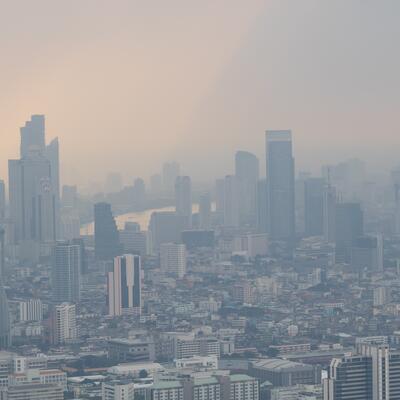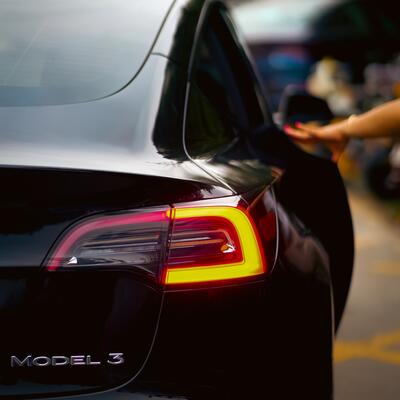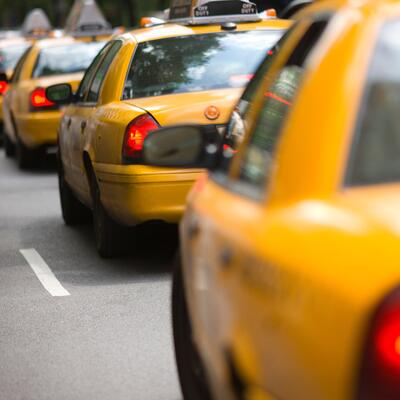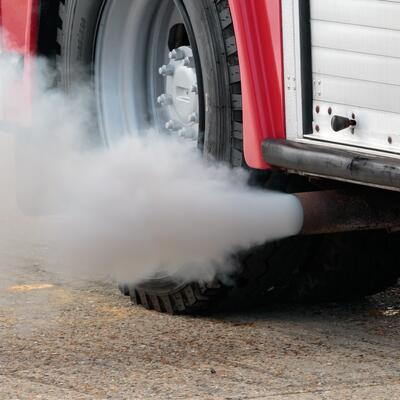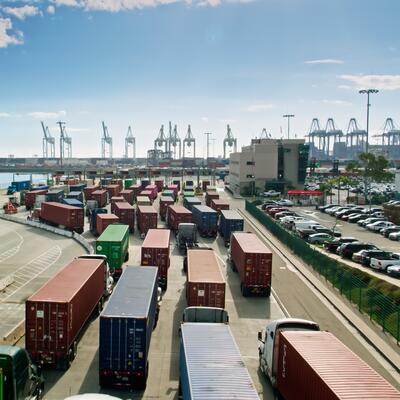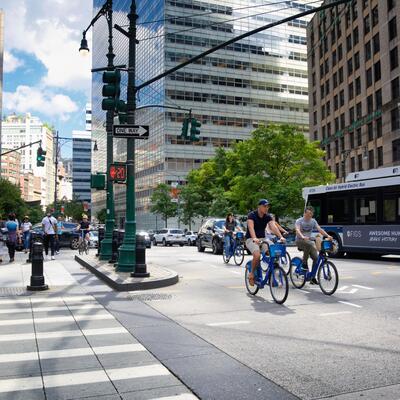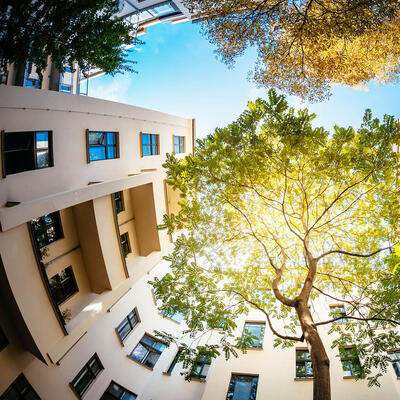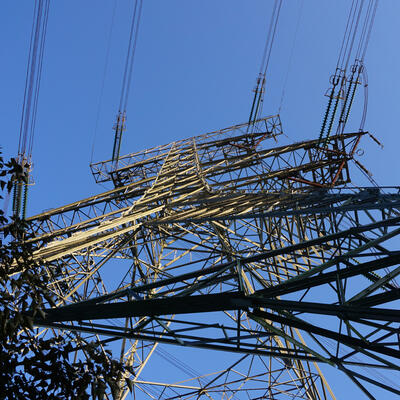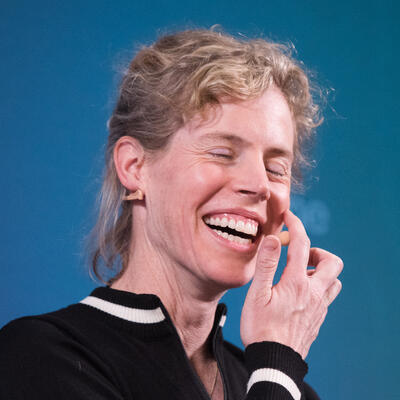
Chain Reaction: Why Two Wheels are Better than Four
Guests

Amy Harcourt
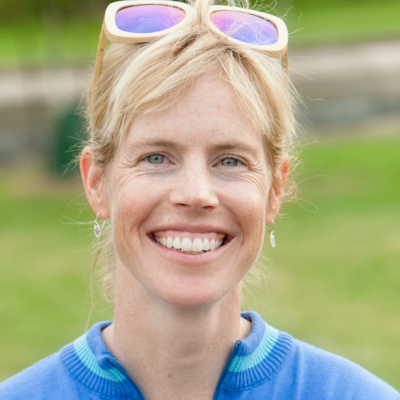
Caeli Quinn
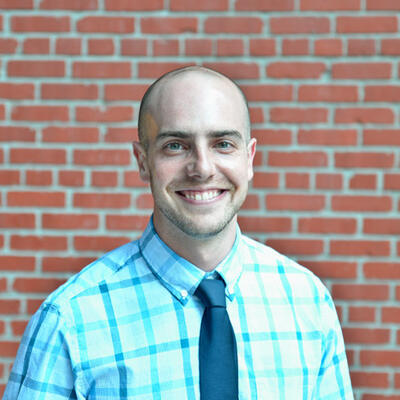
Brian Wiedenmeier
Summary
Getting out of a car and onto a bike is one of the best things you can do for the climate and your personal health. Bike lanes are growing in American cities from New York City to Houston, the country’s oil and gasoline capitol.
Guests:
Amy Harcourt, Co-Founder/Principal, Bikes Make Life Better, Inc.
Caeli Quinn, Co-founder and Executive Director, Climate Ride
Brian Wiedenmeier, Executive Director, San Francisco Bicycle Coalition
This program was recorded live at The Commonwealth Club in San Francisco on June 8, 2017.
Full Transcript
Announcer: This is Climate One, changing the conversation about energy, economy and the environment.
Climate change can be scary and overwhelming. Luckily, one of the simplest ways to fight climate change is as easy as riding a bike.
Caeli Quinn: If there's one thing that you can do, one thing as an individual to have an impact on climate change, it is to bike commute.
Announcer: Cities and smaller communities alike are working hard to encourage more people to bike more often.
Amy Harcourt: There’s a global movement of what's called “8-to-80” cities, in that communities are truly bike friendly when someone who's eight years old and someone who’s 80 years old feel comfortable biking there.
Announcer: And the benefits of biking go beyond reducing carbon pollution.
Brian Wiedemeyer: You see your community reflected. You have conversations that you wouldn't otherwise have. You know, the act of riding gives me hope.
Announcer: Why Two Wheels Are Better Than Four. Up next on Climate One.
Announcer: How bicycle-friendly can we make our cities and communities? Welcome to Climate One – changing the conversation about America’s energy, economy and environment. I’m Devon Strolovitch. Climate One conversations – with oil companies and environmentalists, Republicans and Democrats – are recorded before a live audience and hosted by Greg Dalton.
Across the country, bike commuting grew 60% from 2000 to 2013. That growth happened in some surprising places, including chilly Minneapolis and steamy New Orleans. Despite that increase nationally, less than 1% of commuters take a bike once a week. The cultural and demographic trends suggest American cities will have more cyclists on the road. Urban planners and people working on climate change hope that portends the future. They say bicycles are key to creating more walkable neighborhoods and reducing carbon pollution from transportation, which accounts for about a quarter of national emissions.
Joining Greg today are three people who favor a new balance between cars and bikes. Amy Harcourt is founder of Bikes Make Life Better, a firm that works with companies to get their employees riding bikes to and around work. Her clients include Airbnb, Microsoft, LinkedIn and Salesforce. Caeli Quinn is co-founder and executive director of Climate Ride, a philanthropic organization that mobilizes riders around the country to raise awareness about clean energy. Brian Wiedenmeier is executive director of the San Francisco Bike Coalition. which advocates for bike lanes and other infrastructure that makes bike commuting more appealing and safe.
Here’s our conversation about why two wheels are better than four.
Greg Dalton: Amy Harcourt, let's begin with you. You grew up in the Midwest. You rode your bike everywhere and then you dumped your bike at a certain age. Why?
Amy Harcourt: That would be 16. I dumped it at 16 to get that driver's license and start driving. And honestly, I didn't go back to riding a bike until I was 40.
Greg Dalton: And why did you come back to the bicycle at 40?
Amy Harcourt: Mostly for sport and recreation. I, you know, took it on with a couple of friends and I got really interested and started doing very long sport and recreational rides and really enjoyed it. And then ultimately that turned into bike commuting but that was never the intention.
Greg Dalton: Caeli Quinn, you grew up in Florida. Are bikes legal in Florida?
Caeli Quinn: Florida is not known for its bike culture to say the least. And I did not really ride a bike as a child. But after college I ended up working for a bicycling company, an active travel company, and spent about 12 years bicycling all over the world. And it was my experience riding my bike in China which led me to start Climate Ride.
Greg Dalton: Interesting. And what was it about riding your bike in China?
Caeli Quinn: You know, it was at a time, 2005 or so, when China was undergoing a major transition from bike culture to a car culture. And the pollution was astounding in Beijing and in smaller cities. We would ride our bikes into a town of a million people that wasn’t on a map. And that recognition made me realize in the United States we are so, you know, our issues were so fortunate. And there was very little awareness about climate change and major issues. So I wanted to gather people to ride their bikes to Washington DC and raise awareness of climate change and bicyclists are the perfect people to do that because they are already on the track and doing something that can be so powerful in terms of reducing climate emissions.
Greg Dalton: Brian Wiedenmeier, you also grew up in the Midwest. So tell us about your young relationship with a bike and then, you know, whether you also let it go when you could get wheels.
Brian Wiedenmeier: Yeah, I think just like Amy at 16 you turn that magical age and you have access to personal freedom, the automobile, the American dream, and we really built our cities especially small towns and suburbs in the Midwest around that car. I started riding my bike in chilly Minneapolis actually as a freshman at the University of Minnesota and I did it not because it was an environmental choice, although I certainly had those values then, but really for affordability. I think sometimes we forget that biking after walking is the second most affordable way to get around. And when you're working your way through college, it certainly is an appealing choice.
Greg Dalton: So tell us the national trends bike commuting is up but that’s kind of like solar is up from a very tiny, you know, base. About 1% of Americans get their energy from solar, you know, 1% of Americans might commute. So tell us the big picture in terms of bike commuting in American cities, Brian.
Brian Wiedenmeier: Yeah, it is on the rise and Minneapolis is a great example where you have higher than 1%, it still, you know, sounds relatively small at 4%, 5%. Here in San Francisco we’re at over 4% of all trips taken by bicycle. And those numbers are growing and they’re growing fast, 10% growth here in San Francisco in just the last year in terms of the number of trips taken by bike. And as you use mentioned in your opening, 60% growth nationwide. So while those numbers are small, we’re seeing exponential growth when compared to other modes in terms of private auto trips even relative to transit and walking.
Greg Dalton: And what’s the age distribution? Is it younger people? Is it older people?
Brian Wiedenmeier: The fastest growing group of people biking is 65 and older according to the U.S. census. But, you know, I think there are some stereotypes about who bikes in our cities and that they’re young, they’re male, they’re physically fit and active. What we actually find when people do research is that people who bike reflect by and large people who live in cities. So those young techies commuting or the young affluent folks commuting maybe the most visible during those commute hours. But spread throughout the day all different types of people are biking in our cities.
Greg Dalton: Amy Harcourt, tell us what you're doing with tech companies here in San Francisco and Silicon Valley and why are companies, why do they care, you know, is there some policy pressure to get people out of their cars because parking garages are expensive. So what are the companies doing with you and why?
Amy Harcourt: Exactly. Yes. So they have huge pressure to not have so many people arrive to work in their car. So we do everything related to bikes. So helping bike commuters when they arrive at work having great end of trip facilities, so I know if I ride my bike to work I have a great experience, I can arrive, I have a safe and convenient and secure place to put it. There’s a place for me to clean up. It’s fully accepted. I’m not considered, you know, a weirdo which was, you know, not so long ago. It is more accepted. It's more ingrained into the culture. We also do all sorts of things. People are often afraid to ride, you know, those people who are interested but concerned. Those employees we help them with bike safety, helping them with routing, we put together group rides, they have buddies and people to ride with. We do classes around bike safety and the very basics of bike mechanics. We run on site bike shops. We also do helping getting around during the day. That's a really big one, particularly in Silicon Valley where companies are growing and the footprints are getting so big. It's really – it takes a lot of time to get from building to building. You have a meeting to go to, you’re not gonna drive your car, it's too far to walk so we do big campus bike fleets to help get around and just the efficiencies alone are, you know, are savings. But to your question of why would companies do it, there are all kinds of financial benefits, the wellness benefits, the productivity gains, the savings in transportation parking alone. You know, parking space in a parking structure costs $40,000 for one car. You can fit eight to 10 bicycles in the same space. Reduction in sick days, turnover. In key areas where companies are fighting for top talent, having a strong transportation program and a really solid bike program actually becomes one of those draws as they’re recruiting and trying to attract top talents.
Greg Dalton: Caeli Quinn, you have companies that sponsor teams on the Climate Ride. I saw SolarCity. I’ve done the Climate Ride in 2016. I did it again in 2017. So tell us about the corporate involvement with your Climate Ride companies. Is it just clean energy companies? You don’t have any coal companies?
[Laughter]
Caeli Quinn: We’d welcome it. It’s sort of what name you were saying. Companies see a real opportunity to do employee well-being and also philanthropy and so encouraging their employees to take on a life-changing experience that really is transformational for everyone involved. And we talked about the 1% on average in the U.S. and Canada, people who do urban commuting. And if there's one thing that you can do, one thing as an individual to have an impact on climate change, it is to bike commute. The figures are astounding. If we can get to a 20% to 30% rate of people bike commuting in this country, we’re looking at 11% to 15% reduction in transportation emissions. And that’s huge from taking something that's very inexpensive to do. And when companies, sorry, the government is looking at large transportation projects, they often overlook cycling infrastructure because it’s such an inexpensive part of the project. So it really comes down to cities and mayors who have a true sense of what companies need to recruit people. Other stakeholders in this are realtors who are looking at the real estate market for where people want to live. And they’re the ones who were saying how sustainability and public health in cities are impacted by having a strong bike commuting system. So literally at a city level it's where all this action is happening. And it is astounding that one person riding a bike, an inexpensive bike, can change all of this.
Greg Dalton: Brian Wiedenmeier, I've done lots of changes to my life, solar on the roof, electric cars, don't eat red meat rarely and I could bike commute, but I don't. I'm a middle-aged guy afraid of getting doored. And so help me, a little group therapy here, help me get over my fear of not getting nailed in the 2-mile commute to my sustainability job. I should be doing it, but I'm afraid.
Brian Wiedenmeier: Well, you're not alone Greg. And we know when we talk to people and ask them what's preventing you from riding your bike to work or anywhere else, safety is always the number one answer that comes up. Cities and our country and government need to change that. And it really does come back to infrastructure. So at the San Francisco Bicycle Coalition, we work very hard to build the kind of infrastructure in our city streets that keeps people who ride safe and protected. So it's really about physical separation and providing that both actual safety there is data and research that shows those types of bike lanes that are physically separated from auto traffic are safer, but also the perception of safety so that it removes that barrier or that fear of I may get, you know, hit by a car. It's scary and loud in our city streets.
Amy Harcourt: Can I add something to that? When I moved to San Francisco so I was this, you know, recreational cyclist and I came with a road bike, I was terrified just like you. I lived in the city and I wanted to ride in the city and I didn't know what to do. And I went to the San Francisco Bike Coalition and I took a free three-hour class and it literally changed my life. This was pre-Bikes Make Life Better. But that’s what turned me into a bike commuter. I rode to the class, I was terrified, I left the class three hours later and I was so comfortable in the street because I learned all the ways to be safe just within three hours.
Brian Wiedenmeier: Education is a part of it too. But I think what you're seeing in cities across the country we were talking about that explosive growth, the fastest growing mode of transportation is still small, but it really is that infrastructure that's making the difference and the innovations in terms of physical separation and protection from auto traffic.
Greg Dalton: Bicis Del Pueblo is a San Francisco-based organization that helps people in low income areas recover and fix abandoned bikes. Hugo Vargas [ph] is a volunteer with the group and a high school student. Let's listen.
[Start Clip]
Hugo Vargas: My name is Hugo Vargas. I'm 18 years old. I actually got into mountain biking last year so let's say 2015, oh two years ago. And from there took off my love for the sport skyrocketed. I was like eight years old when I got my first bike and, you know, I fell in love with it. When I got my first bike, I knew nothing like I remember I got a flat and I was like what do I do, do I get a new bike or what do I do. And at present day, I can tell you how to fix a flat and how to make sure your derailleurs don’t get rusted or how to properly lube your chain. And it’s this whole bike thing that's expanded in my life and now I'm proud to being a bike nerd. So it’s awesome. It’s awesome. Bicis Del Pueblo is a collaboration, you know, that's how we got our bikes. And these are bikes that haven’t been claimed, that have been stolen and, you know, just left on the streets and we refurbish them, and we give them out to the community. And we also have people come so they could pick their bikes and, you know, build them from there. And we’re here today at San Francisco Community School at 125 Excelsior Street. It’s our bike workshop, we’re in a bike day and, you know, without this program I couldn't have fixed the flat I couldn't fix before or I couldn’t have changed my brake levers. You know, every time I come back I'm just getting better and better and better. You can have the dopest bike and have the biggest ego, and then you have this kid who has like a crummy BMX bike, but they’re riding bikes, right? As long as you get on a bike, it doesn't really matter because you're having fun.
[End Clip]
Greg Dalton: That was Hugo Vargas a volunteer and high school student, a volunteer with Bicis Del Pueblo in San Francisco. Brian Wiedenmeier, that challenges the notion that all bicyclists tend to be Caucasian, upper middle class, et cetera. So is that really true?
Brian Wiedenmeier: Yeah. And in fact we work with Bicis Del Pueblo as a partner to redistribute those reclaimed bikes that Hugo was talking about. Yeah, again, you know, I mentioned earlier the stereotype of who bikes in our cities and across our country. One of the things we talk about in our work is something called the invisible cyclist. So the person you may not see in that commute and think about somebody that works a late night shift as a dishwasher, for example, and needs to get home after transit stop running. That person relies on their bike to get from their job and in a time when there is increasing costs of living in our cities bicycling can be a lifeline for people to hang on and survive.
Announcer: We’re hearing about bicycle culture and climate change. This is Climate One. You can subscribe to our podcast at our website: climateone.org. Greg Dalton will continue his conversation in just a moment.
Announcer: We continue now with Climate One. Greg Dalton is talking about bike culture and climate change with Amy Harcourt, founder of Bikes Make Life Better. Caeli Quinn, co-founder and executive director of Climate Ride. And Brian Wiedenmeier, executive director of the San Francisco Bike Coalition.
Here’s your host, Greg Dalton.
Greg Dalton: Amy Harcourt, you touched on the idea of identity recently talking about people who bike to work and there's something of a perception that maybe people of a certain seniority or younger people bike. I remember first time I took and started using Bike Share around downtown San Francisco and I got on it and I was kind of wearing business clothes and I feel like, do I look like a dork, do I look like a tourist, what if I see someone I know, like oh my God, they'll see me riding a bicycle, you know, terrible, right? But tell us about, you know, the identity. There is a bit of, you know, identity about who bikes and whether that's cool or the culture at your job.
Amy Harcourt: Yeah, I think things have really changed in that realm. I think for a long time it was so marginalized. There were so few people doing it that it was like, oh you’re one of like, you know, the Lycra-clad and it tended to be more women and younger. But that's really changed and there is, you know, a global movement what's called 8 to 80 Cities and that communities are truly bike friendly when someone who's eight years old and someone who’s 80 years old feel comfortable biking there. And we’re seeing much more of a split so I think if you head out into almost any city, or you ride public transportation that’s twinned up with bikes and you look to see who those bike commuters are, you see a great spread in terms of gender, age, ethnicity. I think it's what Brian was saying that it really does represent the community.
Greg Dalton: But Brian, you know, America has a deep romance with the car. And, you know, is that a romance that they’re gonna break up and/or –
Brian Wiedenmeier: It had a romance with the bicycle before it had a romance with the car. You know, our streets were not built for cars originally. They were built for horses but certainly bicycles are one of the things that helped roads first to be developed and paved in our country. So if our memories go back a little bit longer, we know that this country is capable of getting around lots of different ways. Certainly, we have built our cities in the 20th century around the automobile. And the great project of the 21st century I think is building out those cities for other modes of transportation and the bicycle being one of them.
Greg Dalton: So give us some examples. There's Barcelona, superblocks, Mexico City, give us some examples of cities around North America and what they're doing innovative to either have protected bike lanes or distributing that balance of power and real estate on American city streets.
Brian Wiedenmeier: Sure. So one of the densest cities in this country, New York City, I was just there in April, Manhattan has been transformed in the past few years with a network of physically protected and separated bike lanes. Sometimes that means moving the row of parked cars from the curb over so that you can fit a bike lane in between the curb and those parked cars and that’s something we call a parking protected bike lane. Or in the case of Vancouver in British Columbia has a network of protected bike lanes in its downtown core, and they are using concrete planters with foliage and greenery, really attractive to physically separate that bike lane from auto travel. Those are just two cities as diverse as Chicago, New Orleans, you mentioned the Twin Cities, Minneapolis and St. Paul, Austin, all across this country we are seeing city leaders and advocates working together to really transform the fabric of our streetscapes to accommodate more people biking.
Greg Dalton: It’s even happening in Detroit, your Motor City. You go there, of course Shinola a pretty cool company that makes bikes and watches and many cool things. And is it happening there as well?
Brian Wiedenmeier: Yeah. Detroit is a leader and you've got smaller cities too. So not just our big cities, but places like Fort Collins, Colorado, Madison, Wisconsin that have been real leaders in this movement for better and higher quality infrastructure for people who bike.
Greg Dalton: I wanna talk about bike sharing that’s something that's happening across the country. There's a company called Motivate based in San Francisco. They operate bike sharing in Washington DC and a number of cities. They have 1.5 million shares, I’m not sure if that’s annually or cumulative in New York City, 340,000 in Washington DC, about 350,000 in Chicago. Amy Harcourt, the Bay Area actually is down there pretty low 28,000 just ahead of Jersey City. Ouch.
Amy Harcourt: Interestingly enough, you know, talking about like Detroit and the Motor City and our American love affair with cars, Ford, you know, branding as a mobility company and being the big title sponsor for the expansion of the Motivate Bay Area Program is really quite interesting. They’re a car company but they’re gonna brand themselves over how many bikes, Brian?
Greg Dalton: 7000.
Amy Harcourt: 7000 throughout the Bay Area.
Brian Wiedenmeier: 4500 just in San Francisco.
Greg Dalton: And so Brian Wiedenmeier, why is a car company sponsoring a Bike Share program?
Brian Wiedenmeier: Well, I think, you know, Ford is reading the tea leaves and certainly in our urban centers they’re seeing that the future of transportation isn’t private ownership.
Amy Harcourt: I would just say if you can’t beat them, join them.
Greg Dalton: Yeah, Bill Ford said that on this stage when he was here about car sharing. It didn't get to bike sharing.
Brian Wiedenmeier: Car sharing, bike sharing, you know, Ford has all sorts of new innovative ideas that they've talked to us about in terms of what they're calling smart mobility and really rethinking the way people get around in cities.
Greg Dalton: Caeli Quinn, tell us about when you were riding through Pennsylvania during the election, the presidential election, running through Pennsylvania and what was that experience like and what kind of people did you encounter. Was this, you know, a bunch of crunchy environmental people riding through their neighborhood.
[Laughter]
Caeli Quinn: Why we looked crunchy. You know, it was fascinating because the pace of a bicycle allows you to really observe. And we were riding through Pennsylvania and every single sign was a Trump sign. We didn't see a single Hillary Clinton sign except for a couple of “Hillary for Prison” signs for hundreds of miles. And so everyone on that ride new before the election exactly what was going to happen. And I really think that in terms of uniting us again, and I think bikes and climate coalescing movements, which is an important part of what needs to happen right now, getting our elected officials out on bikes experiencing rural America and understanding why it's so different from urban America. But I do think many of the solutions that Brian and Amy are talking about work in small rural communities. I live in a town of 8000 and we’re putting in a protected bike lane. We also have, we’re working on a city climate action plan and that's a great area for bike coalitions to intersect with the climate movement because bike coalitions need to be involved in climate action plans. The big cities are now having them, but the smaller towns they’re developing them as well. And bikes are gonna be a part of that.
Brian Wiedenmeier: Biking and the benefits of biking are not just about climate or the environment as we talked before. Bikes mean jobs. Biking is a huge industry in the United States between retail, between manufacturing. All of the studies that have been done on the economic impacts of cycling, on commercial corridors, people who bike to shops spend more money on average than people who drive. So if an environmental argument isn't resonating, there’s an economic argument to be made too. And, you know, small towns are places that are suffering economically, biking can be a boon.
Greg Dalton: So help me out with that one. I’ll challenge that one. The people who bike spend more. So does that mean you like load up on jewelry, that’s like easy to carry but they cost a lot of money. Do you think that you can load up your car with a bunch of stuff?
Caeli Quinn: Well, bike touring and then there's also in urban areas people always talk about, oh if you take out that parking lot it’s gonna wreck my business, those two parking spots. They tend to make more pass-bys of the business or other sorts of businesses develop, you know, small places to eat, things like that. With bicycle touring especially in rural America, it can revitalize towns. A bike tour comes through with several hundred people and all these people are overnighting, they’re eating, they tend to spend I think it’s $70 more every couple of days than a regular tourist does. And they engage with the community. So in a way it's definitely in the quiver for retooling small communities in America.
Greg Dalton: And Caeli Quinn, you live in Montana, kind of a purple part of Montana near a national park and so it’s kind of natural there, right, to be near national park for that to happen. But does it work for other rural parts, I mean, you know, national parks are kind of a special place to lend themselves to that kind of activity.
Caeli Quinn: Yeah, I’d say we’re purple. I mean, when we decided to redo our downtown and have bump outs to create bicycle parking and protected walkways for pedestrians, a petition went around called Keep Whitefish SUV Friendly because we were moving two parking spots I think per block.
Greg Dalton: This is Whitefish, Montana.
Caeli Quinn: And so, you know, I would say I think it does have great impacts and potential for areas. There are many bike rides that have been put in in rural parts of Montana, Idaho, that bring in people and, you know, there's incredible beauty to be, you know, experienced. So the economic impact of tourism is in the millions of dollars for sure for the state.
Greg Dalton: There also was a legislative effort in Montana to make biking more difficult, outlawed on certain two-lane roads. Caeli Quinn, tell us about that.
Caeli Quinn: Yes, it did receive national attention. Our legislature meets every two years, so there's always something exciting they’re working on or diverting our attention from other things. And so, you know, that’s the urban rural divide, you know, the college towns like Missoula and Bozeman and places like Whitefish, everyone wants bikes because it brings jobs, you know, especially in rural America you’re seeing people who work from home more or work for tech companies but are, you know, living in small towns. And they want bikes and they want access, they want it safe for children commuting. What were the commute rates of bike commuting to school it was 50% in the late 60s and now it's 10% or less. And so that simply has to change. So back to what our legislature did, they wanted to ban bicycles on two-lane roads in Montana until they really realized that it's all two-lane. And it was going to ban wheelchairs, anyone using a road in Montana. So it was actually supposedly the representative did it as a joke and it ended up being attached to a bill and then it was taken out later. So we deal with that kind of stuff in Montana.
Greg Dalton: We’re talking about bicycling in small towns and large towns in United States with Amy Harcourt, Caeli Quinn and Brian Wiedenmeier. I'm Greg Dalton. It’s time for lightning round. In the first part I will mention a thing or phrase and our guest will blurt out the first word or phrase that comes to their mind, unfiltered, and with complete disregard for what their mom, their boss or anyone else will think. So first for Caeli Quinn, middle-aged men in Lycra.
Caeli Quinn: They do make baggy shorts.
[Laughter]
Greg Dalton: Amy Harcourt, bike sharing programs with docks at fixed locations.
Amy Harcourt: Old school.
Greg Dalton: Brian Wiedenmeier, San Francisco Mayor Ed Lee.
Brian Wiedenmeier: Mustache.
[Laughter]
Greg Dalton: Amy Harcourt, paying employees to bike to work.
Amy Harcourt: Not a bad idea.
Greg Dalton: Caeli Quinn, Lance Armstrong.
[Laughter]
Caeli Quinn: What a dope.
Greg Dalton: Now for the second part of our lightning round, I’ll ask a question of our guests and they will answer true or false. Caeli Quinn, bicycles are preventative medicine.
Caeli Quinn: True.
Greg Dalton: Brian Wiedenmeier, too often bike manufacturers focus on sports and performance bikes over commuting bikes.
Brian Wiedenmeier: True, and to their peril.
Greg Dalton: Amy Harcourt, true false. Some bicyclists are total jerks when they interact with motorists.
Amy Harcourt: True.
Greg Dalton: Brian Wiedenmeier, many cyclists flout traffic laws.
Brian Wiedenmeier: False.
Amy Harcourt: He said many.
Brian Wiedenmeier: Many.
Amy Harcourt: Yes. He didn’t say any.
Brian Wiedenmeier: Same rights as anybody else.
Caeli Quinn: That’s right.
Greg Dalton: Fact checkers will weigh in on that one.
[Laughter]
Caeli Quinn, the environmental movement struggles to move beyond its base of white men and women.
Caeli Quinn: True.
Greg Dalton: Brian Wiedenmeier, you have taken a date out on your bicycle. Two people, one bike.
Brian Wiedenmeier: False.
Greg Dalton: I did that in China but they didn't last very long.
[Laughter]
Caeli Quinn, true or false. When you were married, you and your husband exchanged mountain bikes rather than wedding rings.
Caeli Quinn: True.
[Laughter]
Greg Dalton: Amy Harcourt, true false. You have given the finger to a motorist in recent memory.
Amy Harcourt: False.
Greg Dalton: Brian Wiedenmeier, true or false.
[Laughter]
You have flipped the bird at a driver in recent memory.
Brian Wiedenmeier: False. But I was spit on the other day by an Uber driver.
Amy Harcourt: Ooh.
Caeli Quinn: Ooh.
Greg Dalton: Ooh.
[Laughter]
Last question. Caeli Quinn, you don't dare flip off drivers in Montana.
Caeli Quinn: True.
[Laughter]
Greg Dalton: Because you might get shot.
Caeli Quinn: False.
[Laughter]
Greg Dalton: Okay. Alright. That ends our lightning round. Let’s give them a round of applause.
[Applause]
There’s a lot of talk these days about robotic cars and how they’re gonna change the way we get around. So Brian Wiedenmeier, is that a good thing robotic cars? There’s a lot of excitement in technology circles about how these things are coming and they’re gonna change our world.
Brian Wiedenmeier: Yeah. Autonomous vehicles, another name for that, a self-driving car and certainly here in San Francisco we've seen them on our streets already. The long term promise, I think, for autonomous vehicles is one of safety, right. We know that over 90% of traffic collisions are caused by human error. So if you take that human error out of the equation, there's the potential to make our roads much safer. I would say on the flipside, an autonomous vehicle is still a vehicle. It still has an internal combustion engine, it still takes up the same space on our roads and streets. And so, you know, the impact on our street doesn't change dramatically in terms of emissions, in terms of square footage and usage and wear and tear. So I think the promise of autonomous vehicles is one of improved safety and possibly lessening congestion. But whatever we do we need to make sure that the safety of people who walk and people who bike is prioritized.
Greg Dalton: And you think that means making it painful to drive a car. San Francisco has a transit first policy where they will build a building with 200 condos and 50 parking places that sort of thing. Do you think that actively driving a car should be made more inconvenient and difficult?
Brian Wiedenmeier: I think taking transit, walking and biking, should be made easier. And I think looking at it through that lens is the one where, you know, you’re really focusing on the car and the necessity of the car, and I think transit first policies, designing our streets for people who walk and bike really is flipping that equation on its head in saying we value those modes because of their many benefits. And if we make it attractive and easy, we’ll see people are able to get around just as easily without a car.
Greg Dalton: Amy Harcourt, Apple built a huge new billion-dollar campus and building. They put in a massive parking garage. Are bicycles sort of an add-on, are they actually eating into sort of the car dominance at your corporate clients.
Amy Harcourt: Well, sadly bicycles are not yet quite eating into the car dominance. And it is true and it has been true for a long time that cars are always prioritized and bike facilities are always an afterthought. But we are seeing a shift in that. Like certainly over the last five years, we're getting, for instance, invited in much earlier on either with our corporate clients or by real estate developers, architects, we’re getting invited in much earlier in the process, help us think through before we build it. How do we build in bike friendliness, basically prioritizing the bike parking infrastructure much earlier in the process. So we’re not quite there, but all of the early signs are there and I think we’re gonna absolutely see a shift in that in a big way.
Greg Dalton: Brian Wiedenmeier, batteries, a lot of big advancements in battery technology, there is a battery-powered bicycle whenever someone passes me these days. I first looked to see if they’re battery-powered, sometimes yes, sometimes no. So how’s that gonna change bike culture when you can kind of, you know, take some of the effort out of it.
Brian Wiedenmeier: Yeah, well I think electric-assist bikes that have the ability to be powered by a battery remove some important barriers to physical ability certainly in a hilly city like San Francisco, the barriers of topography, but also for families that want to bike with their children to school or to the grocery store. Electric-assist bikes can make that possible for them. So part of the solution I think to some of those more difficult trips where somebody might say to themselves, I can never see myself doing this with a bike, an electric-assist or motorized bike can help you do that.
Announcer: You're listening to a Climate One conversation about bike culture in America. You can check out our podcast at our website: climate one dot org. Greg Dalton will be back with his guests in just a moment.
Announcer: You’re listening to Climate One. Greg Dalton is talking about bike culture and climate change with Amy Harcourt, founder of Bikes Make Life Better. Caeli Quinn, co-founder and executive director of Climate Ride. And Brian Wiedenmeier, executive director of the San Francisco Bike Coalition.
Here’s Greg.
Greg Dalton: Brian Wiedenmeier, tell us the story of the remaking of Times Square and how instrumental that was in re-creating a very important place in the American imagination and culture.
Brian Wiedenmeier: Yeah. The heart of it all, right? And if you think about Times Square, what its image in the public imagination, is this place with bright lights and crowded streets, right? What had happened in New York City a few years back was you had a mayor so you had a leader who had a vision, Michael Bloomberg, and was willing to invest his political capital and resources in remaking New York City into a more people-friendly place and ultimately a safer place. And he hired somebody a woman named Janette Sadik-Khan as his transportation commissioner who really was a problem solver, is still a problem solver and had a vision for Times Square of removing autos from that space and really opening it up to people walking and biking. And they started out by doing that just as a pilot. So this is the power of a pilot. You're not necessarily saying you’re gonna make a permanent change to our city streets, you’re gonna try something out. And you can do it cheaply with paint and, you know, removable concrete barriers. And they tried it out and lo and behold, people loved it. And chaos did not ensue, the world didn’t end, people flock to Times Square in even greater numbers. And so they have just finished making those pilot changes permanent in Times Square.
Greg Dalton: There are some places where cars have been pushed out, I’m thinking of the Santa Monica Third Street Promenade where people walk and there are no cars, of course there are huge parking garages all around it where people drive to go there. What’s the balance? Because there is no car traffic and there is no business.
Brian Wiedenmeier: We’ve talked a lot about transportation, we haven't talked much about the built environment, right, about how we build housing, how we build – we talked a little bit about how we build workplaces and what Apple is doing down in Silicon Valley. But, you know, I think the key there is really making sure that we’re smart about our land-use and we’re building in density. So you talked about, you know, new developments that don't have as much car parking. Well, if you do that densely enough and you put them next to shops and jobs and places where people want to go, they don’t need to drive there and then park their car and get on a bike. So I think that land use and transportation planning go hand in hand.
Greg Dalton: Amy Harcourt.
Amy Harcourt: Yeah, if you look at Amsterdam, we think of Amsterdam as being, you know, the holy grail of bike-friendly which it is. But it wasn't in the 70s. In the 70s it was entirely car centric and, you know, their entire transformation included disincentives for bringing your car into the city center and creating areas that are only bike and ped and look what’s happened over the decades.
Greg Dalton: London recently pledged $1 billion for bike infrastructure. They have congestion pricing. That doesn't go over so well in the United States.
Brian Wiedenmeier: It hasn’t yet. And I think, you know, it's going to take another bold visionary leader like a Michael Bloomberg or Sadiq Khan who's the mayor of London to come up with a proposal and take a risk and try to put the resources behind it.
Greg Dalton: That but it ultimately comes to people deciding. That comes up in San Francisco, congestion pricing, you gotta pay more to come into downtown. People don't like it. The merchants, Union Square, fancy high-end shops they don't like it because they’re destination people driving into San Francisco. There seems like there's lots of powerful forces against it including democracy.
Brian Wiedenmeier: Yeah. Well, listen. We talk about a shared resource, our streets are a public space and how we use those public spaces is always open to a political process. And that's the fun part of this job, right? But I would go back to the idea of a pilot and trying something out and seeing if it works without making it a permanent change first.
Greg Dalton: Caeli Quinn, what's your vision if the Climate Ride is successful, what does the world look like?
Caeli Quinn: Well, that would be terrific. We’d all be biking, there’d be clean air for everyone, jobs, job creation. I think when you look at Climate Ride I like to look at in terms of what was the model we chose. It was using the bicycle as a way to jumpstart philanthropy for a sector that is woefully underfunded. So less than 3% of charitable-giving in the United States even goes to the environment and that includes animal welfare. So of the nearly $400 billion that foundations and people give to causes, less than 3% goes to the environment, bike coalitions I don't think even registered on that.
Greg Dalton: Education and health get the line –
Caeli Quinn: Religion about 40%. And then health and human services, and then arts, humanities, culture and then environment.
Greg Dalton: So if you have rides into Washington DC, other places you're trying to affect policy, you have different rides around the country, Montana, Boston, California. What’s the policy angle. You try to get Congress?
Caeli Quinn: We do on our DC ride. We give people a voice, meeting the representatives in person which most Americans have not done in DC. So that is a very powerful experience for people being involved in the public process. And then also the grants that we give to bike coalitions, about 30% of our grants go to bike coalitions, and then climate action groups and environmental groups the other 70%. And the idea is, you know, use those funds in a way that can help advance your missions because so much activity is happening on local level while we have these larger climate action programs on a national level. So primarily when you look at other causes, things like health and disease, for example, they have thousands of rides and the top 10 events in the U.S. raise $1.6 billion a year. And we at Climate Ride really the only event on a national scale working for environmental and transportation justice issues. So I look at that as incredible opportunity. When we’re talking about let's move from 1% to 11% of people riding bikes, I see it as a let's move from $1 million to $1 billion in grants.
Greg Dalton: Interesting that the others, lots of rides for every disease has a ride but environmental things not so much. When I was out on the Climate Ride, I spoke with some cyclists about their story.
[Start Clip]
Shamini Dhana: My name is Shamini Dhana. I’m the founder and CEO of Dhana Inc. Climate Ride has been a passion of mine since it's the only annual charity event in the country that raises funds for the environment, sustainability, bike advocacy and climate change.
Laura Torres: My name is Laura Torres. I’m doing the Climate Ride as an NPCA staff representative, we are the National Parks Conservation Association. Climate change is affecting many communities, it’s affecting the national parks so it’s an important issue for our organization.
Dirk Rosen: Dirk Rosen. Marine Applied Research and Exploration which we call MARE. I was on a research ship for several weeks right before the ride and so I used an exercycle and found out that that's not a good proxy for a real bicycle.
Shamini Dhana: I think it's a great challenge and after a while, of course, it's mind over body. But, you know, how many of us get to really breathe in this natural beauty, right? And it's something to be said about having the time and to be amongst amazing people doing such good in the world.
Laura Torres: Two organizations who are really doing amazing work around the LA River are Amigos de los Rios and there's also Friends of the Los Angeles River and we are supporting their effort to bring revitalization to the river, to bring back native species, to create a healthy ecosystem a lot more closer to most of the communities in Los Angeles that’s accessible.
Dirk Rosen: The warming of the ocean is a big issue and the methane gas that’s seeping out of our feedlots is blanketing the earth and causing temperatures to rise, and the one taking the brunt of that is the ocean. So ocean temperatures are rising, it's causing some stress and disease and death in some of the animals, toxic algal blooms in certain parts of the ocean and migrations of animals to other places.
Shamini Dhana: Most people don't realize that the whole entire fashion apparel industry is the second most polluting industry in the world. We make use of dyes to color the fabric and ou can actually take a look at the rivers in some of the developing countries and see what the next fad color is.
Greg Dalton: We finished a 100-mile ride today, how was that for you? Was that your first century?
Dirk Rosen: I've done two with Climate Ride and one with Oakland Unified School District. I was really glad I did it. t was beautiful territory and I couldn't believe how many grapevines there were along the end sucking that river dry. Well after 100 miles you never know what you’re going to say.
[End Clip]
Greg Dalton: Those were some voices from the Climate Ride. We’re gonna to our audience questions and invite you to join us and briefly state your name and your question.
Female Participant: Hi. My name is Jeanie. I’m a city planning consultant and I work with communities that are trying to retrofit some of their streets and often run into challenges between bikes, pedestrians and buses in particular, trying to pull in and out of some of these changes to the street with changes to where bicycles are oriented. So what do you think about all streets being for all modes versus having streets that are more transit-oriented versus streets that are more bicycle-oriented.
Greg Dalton: Brian Wiedenmeier.
Brian Wiedenmeier: Sure. Yeah. You know, I think every city is unique and I don't want to say that one set of road use standards that might work here in San Francisco may be completely different from something that works in Cleveland. So I don't want to make too many broad blanket statements. But what I will say is that we've seen a lot of examples of street design where different modes of transportation have been integrated in really smart ways. So, for instance, a transit boarding island in the middle of the street with a bike lane between it and the sidewalk so that you have physical protection, you have a safe and nice place for people to wait for the bus and you have a nice wide sidewalk for people walking. So I think there are some really innovative examples across our country of the ways that urban planners have been able to tackle this problem and really accommodate as many modes as possible and not try to pit different road users against one another because when that happens, nobody wins.
Greg Dalton: It gets pretty, yeah, pretty fierce out there. Let’s go to our next question in Climate One.
Male Participant: Hello. Austin McInerny with the National Interscholastic Cycling Association. Thank you very much for your efforts improving cycling in our communities and ultimately our lives. As an organization that’s very invested in trying to improve cycling for youth and opportunities for younger generations which I think are critical in this issue in order to change the dialogue within families and grow the next sort of set of adults who ride, I’m curious what suggestions you have from the communities that you're working in or examples of where youth cycling is working and how do we improve that in this country.
Greg Dalton: Who’d like to tackle that? Youth cycling. Caeli Quinn.
Caeli Quinn: I will. I think the improvement of getting safe routes to school is an incredibly vital program in every community, so supporting that. And a lot of it is about I see it in my town, it's about educating other families about it. You know, families that are driving recklessly, idling around the schools, you know, tailpipes at the playground. So I think that is the first place to start. I also see a lot of mountain biking programs developing particularly in my area to get kids on bikes and in very athletic way at a young age. Those are growing very rapidly.
Greg Dalton: Amy Harcourt.
Amy Harcourt: Brian when you were talking about e-assist bikes and that really helping to facilitate a lot of those everyday trips, parents who can take on that and start taking children to school when they're very young or taking them on trips and that really begins to habituate their whole attitude of this is how we do it. It becomes unremarkable and that's what I think we’re striving for.
Caeli Quinn: They said the car culture we live in that when they asked the parents, you know, why don’t you ride with your kids to school, it's, you know, roller safety and then one of the next one is weather. And, you know, the weather is, you know, it rains some days, it’s sunny some days, it snows some days, that’s kind of not changed much since the 50s. But we are so used to being in cars now that just even breaking down that barrier of being outside is a challenge.
Greg Dalton: We’re talking about biking culture and climate change with Brian Wiedenmeier, Caeli Quinn and Amy Harcourt. I’m Greg Dalton. Let’s go to our next question.
Greg Dalton: Let’s go to our next question.
Male Participant: Hi. My name's Carlos. This is the question. You said that you took a three-hour course that made you more comfortable. What did they teach you in that course to make you more comfortable?
Amy Harcourt: Oh, that’s such a good question. Thank you for asking that. Everything about how to safely navigate streets. And so it was a lot of what are the rules of the road when you're a cyclist on the street and how do you interact with cars. So one of the things I remember strongly was I thought that I was safer if I hugged at the curb, you know, being out of the way of the cars in the lane. And what I learned was as I was hugging a curb, I would hug the curb and then come out to go around the parked cars, hug the curb, I was doing just the opposite. Because cars behind me see a cyclist come out, disappear, come out, disappear, or hugging cars, you know, if the cars are parked along the side, you know, a perfect example of where you get doored. So I learned all of the ways to, for instance, take a lane like it’s actually okay as a cyclist, it's legal, it's good, it's fine. You can take that lane like you are a car and you're actually a lot safer. Learning how to navigate intersections. That's a big one, you know, what are all the various ways to do safe left hand turns or take yourself to the crosswalks if doing a left is not as safe. All of those sorts of things.
Greg Dalton: Getting doored is when a car passenger opens up a door and the bicyclist runs into it. Yeah, it does feel safer. We are getting close to the end and I wanna ask each of you, climate can be sometimes overwhelming, there's been a lot of rough news lately. Caeli Quinn, what gives you hope knowing that how much carbon pollution humanity’s put up in the sky that we can bend those curves and stabilize the climate for our kids?
Caeli Quinn: I think right now is an important time. And when I look at Climate Ride in particular the diversity we’re seeing grow on the rides. I work with the bike coalitions to bring teams to the ride that reflect their diversity of their communities. I think right now with all the changes that are happening and the activism people feel and the coalescing of all of these movements together, it's a powerful voice and I would say to any woman, person of color or young person get on boards, get on school boards, get in your local chamber of commerce, get involved because your voice matters more now than it ever has. And will be a big part of the shift happening much faster.
Greg Dalton: So there has been no despair because Trump pulled out of Paris and the fossil fuels are being revived, that sort of thing.
Caeli Quinn: Well, the news this week of all the cities signing on board and saying we’re gonna move this forward, this is happening at a city level. It is not happening at a national level with our administration and the government in place now. And visionary leaders will drive it forward. But I really think it's the voice, as I said, of this next generation coming up, particularly diverse voices that are going to change this paradigm fastest.
Greg Dalton: Amy Harcourt, what gives you hope that this monumental challenge that we’re up to it.
Amy Harcourt: Yeah, it's very similar I think where we are today what’s coming from the White House has really galvanized people in a very grassroots level. And I feel very hopeful because I think there are small changes we can make. So I think very specifically in my realm of influence it’s helping, frankly put more butts on bikes. You know, how do I enable that. And I read a statistic where it’s like if everybody in the country who works 5 miles or less from their home, so their bike commute is 5 miles or less, if everyone in that situation rode their bike just one day a week and left their car home, it's the equivalent of taking a million cars off the road. To help propagate that message so that everybody can say, I could do that, I actually can make that change. Part of our Bikes Make Life Better credo, part of it is one bike makes a difference, many bikes shape the future. And that's what gives me hope.
Greg Dalton: Brian Wiedenmeier. Hope.
Brian Wiedenmeier: Yeah. You know, it's tough right now. Social media this thing that was supposed to bring us together more than ever has isolated us and polarized us to the degree that we haven't seen and I didn't find hope in riding my bike and being out among people and interacting with them in a way that I wouldn't behind the barrier of an automobile. You see your community reflected. You have conversations that you wouldn't otherwise have. So, you know, the act of riding gives me hope.
Music: In
Announcer: Greg Dalton has been talking with Brian Wiedenmeier, executive director of the San Francisco Bike Coalition. Amy Harcourt, founder of Bikes Make Life Better. And Caeli Quinn, co-founder and executive director of Climate Ride, which mobilizes cyclists around the country to raise awareness about clean energy.
To hear all our Climate One conversations, subscribe to our podcast at our website: climateone.org, where you’ll also find photos, video clips and more.
Please join us next time for another conversation about America’s energy, economy, and environment.
[Applause]
Greg Dalton: Climate One is a special project of The Commonwealth Club of California. Greg Dalton is our Executive Producer and Host. Jane Ann Chien is the producer. Kelli Pennington Directs our Audience Engagement. Carlos Manuel is our Booker and Associate Producer. The audio engineer is William Blum. Anny Celsi and Devon Strolovitch are the editors. The Commonwealth Club CEO is Dr. Gloria Duffy.
Climate One is presented in association with KQED Public Radio.
Music: Out
